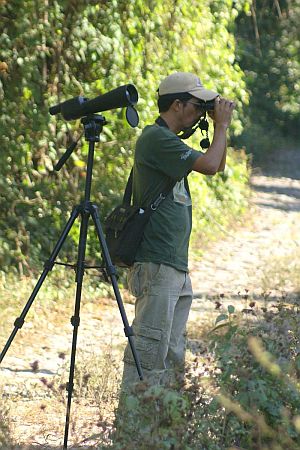San Pancho, Mexico - Luis Morales is a Marine Biologist, Director and Founder of the San Pancho Birding Club, and the owner of Birding San Pancho. Luis has vast experience on leading nature tours, both in land and aquatic habitats.
He has lived in San Pancho for 3 years and has become not only a frequent and avid observer of the local birds and nature but also an educational resource for our community and an environmental activist to help in preserving and restoring natural habitats.
Here is a recent excerpt from his Birding San Pancho Blog:
This morning (July 15) as I went birding in the estuary, which by the way opened last weekend after a heavy rain combined with a strong swell left the beach full of water-hyacinths (and sadly some trash) besides happy surfers with the perfect break that the newly opened estuary usually brings, I realized that the birding season 2010-2011 could be considered as “over.”
What do I mean by this?
Biologically there are two very evident aspects:
1. Most tropical species like the Black-throated Magpie Jays, Rufous-bellied Chachalacas, Orange-fronted Parakeets and Citroline Trogons - and even the migratory species Black-bellied Whistling Ducks have started a new cycle with the birth of their offspring. By now all of the tropical species are experiencing the challenge of survival of hatchlings; some have fledged already and display their immature/juvenile plumages.
2. Most migratory species have fledged, leaving only the resident or as we call “tropical” species with the exception of a few summer migrants such as Blue-black Grassquits and Sulphur-bellied Flycatchers and some late Laughing and Hermanns' Gulls.
Socially and economically it means there are not many more tours since there are few tourists and the rains, humidity, heat and BUGS!, make birding and other outdoor activities more challenging and sometimes just impossible.
So, just like the birds do, this is the time for locals to develop new plumages, to re-shape and remodel our nests (perhaps by repairing leaking roofs or adding some paint here and there) and to prepare our babies (new projects) for survival in the next birding season.
Enjoy the summer, either if you are here in San Pancho or somewhere else; please remember to join Birding San Pancho or the San Pancho Birding Club on your next visit to the Nayarit Coast or Puerto Vallarta area. Our team will have new members, partners, projects, tours and much more fun and natural beauty to share with all of you!
Don´t miss the next issue of La Voz San Pancho Newsletter, I'm planning to share with you a report of the species registered during the 2010-2011 season.
For more information about bird watching in San Pancho, visit BirdingSanPancho.com.


